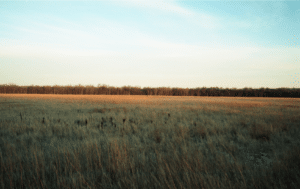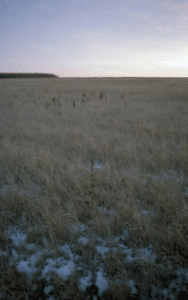Native Grasslands Are Our Past and Our Future
 Written by Hannah Whitlaw on Grasslands in Canada. Photograph credits to Jonathan Van Elslander (@jonnyvan1 on Instagram).
Written by Hannah Whitlaw on Grasslands in Canada. Photograph credits to Jonathan Van Elslander (@jonnyvan1 on Instagram).
Only a few hundred years ago, much of North America was covered by grasses reaching up to 10 feet tall, while wildflowers, lichens, liverworts and other plant life flourished below. Tens of millions of bison grazed the land, wildfires maintained balance between native grasses and encroaching woody plants and trees, and grassland birds soared above. Native prairie grasslands which are comprised of a mix of tall-grass, mixed-grass, and short-grass prairie, stretched hundreds of millions of acres from Alberta to Manitoba. They sustained life for hundreds of species of plants as well as many insects, grassland birds, and mammals. Today, however, native grasslands have been declared the world’s most endangered ecosystems. As a historically, culturally, and ecologically significant habitat, they must be preserved and protected.
Find out more about our work to protect Grasslands in Canada and the Prairies and other natural spaces
- Take action to protect nature like grasslands in Canada.
- Sign up for email updates on our homepage.
- Sierra Club Canada’s work to protect biodiversity, nature, grasslands, and endangered species.
- Find out more about Sierra Club Canada’s Prairie Chapter.
Native grasslands are home to an incredible diversity of life, rarely conveyed in the common depiction of the ecosystems as monotonous fields of grass. From the microbial life of soils underground, to wildflowers tucked between tall grasses, to bison and elk roaming the lands; life exists at every scale. However, with fragmentation and habitat loss largely attributed to land-use change, their vast array of plant and animal life has been threatened. Roughly 70 percent of grasslands in Canada were plowed for commercial agriculture and urban development by 1990, and the remaining habitat continues to be lost today. This large-scale disturbance of contiguous stretches of prairie grasslands has taken a toll on populations of birds who migrate through grassland ecosystems or nest in them, mammals who graze their grasses, and other life who rely on grassland habitat for their survival. Unique species of grassland birds such as the Bobolink, Watehead shrike, and Burrowing owl have become endangered, as have plant species like the Western prairie fringed orchid, and mammals like the Swift fox and Black-footed ferret. Bison were nearly eradicated and replaced with cattle for grazing, while native grasses such as Big bluestem, Switch grass, and Indian grass were largely replaced with agricultural crops for export like corn and soy. Although many species have been lost, the ones which remain and the interdependencies they weave within grasslands, can still be protected. For a quarter section of farmland which may grow a few agricultural crops, the same section of native prairie can support over 100 species of grasses and wildflowers, dozens of animal species, insects, birds, and a myriad of bacteria and fungi. By protecting grasslands and ensuring their connectivity, we are protecting the very heart of life in the prairies.
These habitats are not only home to immense biodiversity, but they also function as major sites for carbon sequestration. While forests remain essential carbon sinks, they store much of their carbon in woody biomass and leaves whereas grasslands sequester most of their carbon underground. This means that when wildfires (which are increasingly occurring at an unnatural pace due to climate change) burn down trees, they release their carbon back into the atmosphere. When fire burns through grasslands, though, most carbon tends to stay in the soil and stored in the roots of plants. Thus although forests store more carbon than grasslands in stable climates, scientists have argued that grasslands will function in some cases as more reliable carbon sinks when we consider the warming and drought-heavy future that lies ahead. Despite this fact, grasslands have little protection compared to forests in Canada. While 94% of Canada’s forest land was publicly owned and managed by provincial, territorial, and federal governments in 2017, only 12% of Canada’s grasslands were publicly owned and this number is only decreasing as more land is sold to large-scale farming operations. All this privately owned habitat means that the potential for governments to create laws and regulations to protect and limit the conversion of our native grasslands has been largely lost. And although in some cases private landowners contribute to the conservation of a given ecosystem, there are currently little to no incentives in place for them to keep native grasslands intact and thus often end up cultivating them as to not undergo opportunity costs. However, when grasslands are plowed, as opposed to burned, much of the land’s stored carbon, even underground, is released into the atmosphere due to the disturbance of soils which take many years to build health. It is clear that these resilient ecosystems will be essential for a future characterized by increasing temperatures and more frequent droughts and wildfires projected in Canada.
A lack of water is characteristic of grasslands, hence the few trees and woody species present in the ecosystems. Though, despite this, their existence is critical for protecting waterways. With deep and dense root systems that trap precipitation and let water percolate into the soil, grasslands help to purify waters that could be potentially dangerous if they reached our large waterways. With the prairies full of industrially farmed land which commonly uses inputs such as pesticides and herbicides, chemical runoff into our waters is something of concern. Having healthy and intact grasslands around allows excess nitrogen, phosphorus, pesticides, and other chemical additives to be filtered out in the soils. Grassland ecosystems are then able to distribute this purified water, providing base flow to rivers and streams. The ecosystems are also important combattants to flooding as plant cover helps water to be stored in the soil for longer than in a bare or heavily cultivated field characterized by poor soil health. These same dense root systems which draw in water help to store nutrients and hold the soil together, making grasslands great buffers against erosion and other climate variabilities.
 Human life in the prairies dates back 10,000 years, with First Nations including the A’aninin, Assiniboine, Cree, Sioux, and Blackfoot who traveled throughout grassland areas, linking their migration to those of bison with the seasons. This enmeshed history with the land is one signifier of the great cultural importance of grasslands, specifically for many First Nations peoples whose traditional territories are within the prairies and the Métis peoples for whom the prairies are their homeland. Canada has made countless commitments to Indigneous peoples – in Treaties, in the Convention on Biological Diversity, in the UN Declaration on the Rights of Indigneous Peoples – to ensure that the natural environment and resources of the prairies are intact, shared, and accessible for all people and that biological resources are accessible for the customary use, education, and economic wellbeing of Indigenous peoples. Canada has not upheld these agreements. We have an obligation, living on Treaty land, to protect these ecosystems and respect the Indigenous ecological knowledge and traditions which have long supported the life and vitality of grasslands and people together.
Human life in the prairies dates back 10,000 years, with First Nations including the A’aninin, Assiniboine, Cree, Sioux, and Blackfoot who traveled throughout grassland areas, linking their migration to those of bison with the seasons. This enmeshed history with the land is one signifier of the great cultural importance of grasslands, specifically for many First Nations peoples whose traditional territories are within the prairies and the Métis peoples for whom the prairies are their homeland. Canada has made countless commitments to Indigneous peoples – in Treaties, in the Convention on Biological Diversity, in the UN Declaration on the Rights of Indigneous Peoples – to ensure that the natural environment and resources of the prairies are intact, shared, and accessible for all people and that biological resources are accessible for the customary use, education, and economic wellbeing of Indigenous peoples. Canada has not upheld these agreements. We have an obligation, living on Treaty land, to protect these ecosystems and respect the Indigenous ecological knowledge and traditions which have long supported the life and vitality of grasslands and people together.
While grassland habitats have offered plants and animals as medicines, food, materials, living space, and cultural value to humans, Indigenous peoples have given back to the land and helped keep them in balance. For thousands of years, both natural and human caused fires would burn for days at a time, keeping balance between the grasses and wildflowers, and the woodier species of shrubs and trees. Cultural burns are slow and low intensity compared to prescribed burns and wildfires and are essential to keep encroaching tree lines at bay, encourage the growth of native grasses and medicinal plants for humans and animals alike, decompose dead plant matter, and increase soil health. However, bans placed on cultural burning as well as other methods of fire suppression have prevented this life-giving practice from occurring. Because of this, we have seen treelines encroaching on remaining grasslands and outcompeting the native grasses and wildflowers that define them. We have seen debris build up to feed increasing amounts of raging wildfires. We have seen a generational loss of important cultural practices. Cultural burns of grasslands are only one example of Indigenous ecological knowledge that must be recognized and respected for its essential role in the maintenance and vitality of the ecosystem. Indigenous voices and leadership will be, and always have been, critical to protecting and restoring native grasslands.
Protecting and restoring grasslands is key in preserving the biodiversity of the prairies, protecting endangered species who have a right to life, storing carbon, providing a variety of ecosystem services for our soils and waterways, and upholding treaties and respecting the traditional territory of First Nations and homeland of the Métis. Throughout the prairies, there are people working with grasslands with these goals in mind. Some private land owners have taken native grassland restoration into their own hands. Api’soomaahka, also known as William Singer III, has worked for over ten years to heal the land by converting his family’s cultivated land back to native grassland with the help of Blood Tribe Land Management. He practices cultural burns of the grassland to encourage the growth of native species, and strives to protect plants like sage, sweetgrass, and mint which have been threatened yet hold great cultural, spiritual, and medicinal importance for the land and for his community. Birds Canada has launched a Grasslands Conservation Incentives Project, which aims to engage ranchers and landowners by communicating financial benefits available to ranches interested in conserving, enhancing, or restoring native grassland. Twenty wood bison were recently welcomed to Métis Crossing Wildlife Park, an area northeast of Edmonton, marking a return of the animal to one of its native areas and to Métis people in the region. Meanwhile, just east of Winnipeg, a family has weaved their Métis culture to their ranching practice, raising a herd of bison at Iron Head Bison Ranch. This is just the beginning of the movement needed to protect, restore, and conserve our native prairie. But, it is something to root for. For the Earth, for our communities, for the traditional stewards of our land, for the many species which depend on grasslands, for future generations, and for the learning and healing that occurs among them: it is essential that we value these ecosystems as the life-giving and life-sustaining environments they are.
Read more about Sierra Club Canada’s policies, impact, and work on grasslands in Canada on our homepage and in our recent impact reports and documents on ISSUU.
